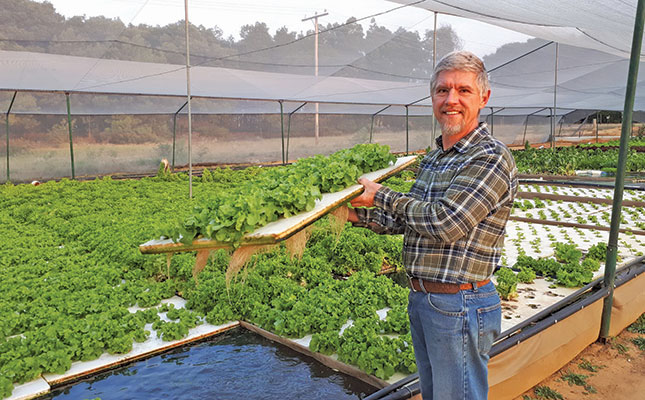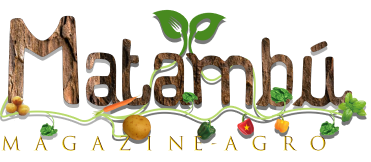[ad_1]
Aquaponics and hydroponics techniques have quite a few benefits over conventional soil-based manufacturing strategies. Magda du Toit spoke to 2 farmers who practise these intensive agriculture strategies.
Photo: Supplied
Hydroponics ensures constant high quality and amount
After receiving his bachelor’s diploma in environmental sciences, Chris Rolfe knew he needed to begin a enterprise that he could possibly be happy with. During his time at college, he additionally took horticulture and agriculture lessons, which sparked a eager curiosity in meals manufacturing. He realised that this was the place his future lay, and selected to give attention to environmentally pleasant farming strategies.
READ How aquaponics advantages kids and the neighborhood
He started his journey by rising mushrooms, however quickly realised that this crop alone was not worthwhile. He then performed a substantial amount of analysis into aquaponics and hydroponics. Realising that his manufacturing data was inadequate, he additionally researched the overall fruit and vegetable market.
In 2019, Rolfe and his enterprise companion, Phia le Roux, launched their hydroponics farm, Go Gourmet, in Pretoria East. Today, they produce each summer season and winter crops, particularly tomatoes, spinach, spring onion, lettuce, and varied herbs.
Starting with 0,8ha, they now have 2ha below netting, with an extra 0,5ha below building. They develop between 10t and 15t of produce every week throughout summer season.
The enterprise is run totally on solar energy, and rain is harvested for the hydroponics system.
“Solar power gives us a great advantage because, apart from the environmental benefit, we aren’t really affected by load-shedding,” explains Rolfe.
Go Gourmet makes use of an digital fertigation system that maintains the proper water pH stage and fertiliser mixes for the varied crops. Water is consistently recycled and filtered, and new fertiliser added throughout the cycle.
According to Rolfe, the hydroponics system permits their crops to develop quicker and additionally ensures higher-quality produce than that grown in a standard system.
Challenges and the long run
Go Gourmet began by supplying produce to the Tshwane Market, and now has a variety of patrons.
“It hasn’t all been plain sailing,” admits Rolfe. “We had to find the right suppliers to set up the infrastructure, as well as a market and clients to sell to on a consistent basis.”
A few essential elements are required for fulfillment, he advises.
“You need to be hands-on to ensure that your farm is running at its full capacity and potential. The input costs for a hydroponics system are high, so efficiency is the key to receiving a return on your investment.”
READ Aquaponics: get it proper, or develop veggies on their very own!
He means that newcomers give attention to spreading threat. “We quickly realised that in order to survive, we had to spread our risk between various buyers.”
He provides that supplying constant high quality produce is just not negotiable. “If you continually provide a product of superior high quality, phrase will unfold. Your purchasers will proceed to assist you. We’ve additionally discovered that our greatest manner of promoting within the contemporary produce business is by phrase of mouth.
“Our mission is to grow healthy, nutritious and good-quality produce hydroponically, and we always try to improve in order to live up to this mission.”
Rolfe says they intention to proceed increasing and enhancing their present infrastructure and techniques.
“We have a 7ha property that we could potentially put under nets and greenhouses. We’re also considering introducing additional crops, and continue to build partnerships along the way.”
Email [email protected].
Aquaponics: a purely natural fish-and-crops system
Aquaponics is a food-production system that mixes aquaculture (breeding, elevating and harvesting fish) and hydroponics. And whereas it’s one in every of a variety of economically profitable agriculture techniques employed all over the world, industrial aquaponics remains to be in its infancy in South Africa.

According to Annemarie Bremner, who co-owns Kleinskuur Aquaponics close to Pretoria along with her husband Colin, aquaponics is a extremely sustainable farming methodology because it makes use of a self-contained ecosystem that mirrors nature.
“Aquaponics differs from hydroponics in that it doesn’t need the addition of chemical nutrients for the plants, as waste from the fish provides the plants with nutrients,” she explains.
She factors out that there’s additionally no build-up of waste that causes the water to grow to be poisonous. “In aquaponics, the bacteria in the waste converts ammonia into nitrates and nitrites, which the plants utilise as their main source of nutrients.”
According to the Bremners, aquaponics techniques usually use 90% much less water than different techniques to develop the identical quantity of produce. They additionally don’t waste water, as it’s recirculated.
In addition, aquaponics techniques can be constructed on non-arable land. “You can buy cheaper land for aquaponics systems, and they can be erected close to cities, highways and the market, saving a lot on transport costs,” she says.
READ Choose the correct hydroponics system to your operation
Fish are a vital a part of the equation. They primarily feed the vegetation, and the stable fibres that stay after the filtering and mineralisation processes can be used to make compost for wicking beds. This means zero nutrient loss.
The fish are offered as soon as they attain market weight, offering an extra supply of earnings that covers many of the operating prices. “We use Nile tilapia [Oreochromis niloticus], as they’re easy to handle, grow fast, and allow for a much higher stocking density than trout, for example.”
The Bremners started their aquaponics journey after Colin was recognized with Barrett’s oesophagus (precancerous situation). “We were looking for the most natural way of producing food [to aid his recovery],” recollects Annemarie.
Grower and producer
Kleinskuur not solely grows contemporary produce, but additionally provides aquaponics techniques. After attending programs in Stellenbosch held by internationally famend consultants, and learning the ideas of aquaponics extensively, Colin designed a uniquely South African mannequin that follows his motto of preserving it easy.
With their KSBA4000 Commercial System, they can produce 4t of tilapia and greater than 16t of tomatoes a month, and 50 400 leafy inexperienced vegetation, comparable to lettuce, a month. The system takes up an space of lower than 0,5ha.
“We call it the KSBA4000, because it contains 4 000 of our patented gravel barrels for fruiting (vine) crops,” says Colin.
Kleinskuur at the moment produces 10 000 heads of lettuce a month for packhouses, and grows quite a lot of different crops, together with Swiss chard, kale, cherry tomatoes, strawberries, microgreens and herbs, that are offered to close by lodges and convention venues.
“We’re also focusing on developing new product lines, such as duckweed,” provides Annemarie.
The new superfood?
Annemarie and Colin launched duckweed, a free-floating aquatic plant that belongs to the subfamily Lemnoideae, into their aquaponics system as supplementary feed for the fish.
As the plant unfold all through the system, they began finishing up analysis on its advantages.
“We already knew that it’s high in protein, which is why we introduced it into our system as a food source for the tilapia. What we didn’t know was that duckweed might also be a source of vitamin B12. Tests are currently being done to confirm the presence of this vitamin in the plant,” says Annemarie.
Apart from its excessive nutrient content material, duckweed has environmental and financial advantages. Annemarie says that it covers all of the open areas of their aquaponics system and thereby prevents evaporation, which, in flip, saves cash. It additionally protects the setting.
“It helps to purify the water by utilizing all the surplus vitamins not absorbed by our different vegetation. This signifies that the water going again to our fish is clear and filtered.
“Poultry and sheep farmers can also use duckweed as supplementary feed in a wet or dry form,” she explains.
In phrases of human consumption, duckweed reveals nice potential to be the following new superfood. According to Annemarie, duckweed comprises between 32% and 35% protein, 20% starch, 5% oil and 20% fibre in its moist kind. It can even be utilized in its unique state or dried right into a powder with out shedding any of its dietary properties.
“Duckweed has been used in Asian cuisine for many years, but it’s only now being considered as a possible superfood in Western countries. Since we don’t use any harmful ingredients in our aquaponics system, we know that our ‘beyond organic’ duckweed is a great supplement for humans,” she says.
People have additionally been recognized to make use of duckweed for the remedy of irritation within the airways, rheumatoid arthritis, and gout.
An improved aquaponics system
In Kleinskuur’s KSBA4000 system, the vegetation act as a filter for the water, which returns to the fish. The water is regularly circulated all through the system. The vegetation are cultivated in two methods:
In a deep-water tradition system, the place vegetation comparable to lettuce, Swiss chard, spinach and most herbs (basil, parsley, rocket and sage, for instance) are grown; and within the gravel barrel system, the place crops comparable to tomatoes, cucumbers, peppers, chillies, brinjals, child marrows, patty pans and different herbs (mint and rosemary, for instance) can be produced.
Aquaponics doesn’t use dangerous pesticides, chemical substances or development hormones, as these would hurt each the fish and the vegetation. According to the Bremners, it produces the healthiest, most nutrient-rich meals that can be grown in a managed setting.
Colin says that theirs has confirmed to be an reasonably priced and environment friendly system.
“The Kleinskuur Aquaponics system is designed to work with nature, not towards it. We save on costly tools comparable to develop lights and ladders for harvesting.
“Our system makes effective use of 84% of the area in the tunnel for growing (the highest in the industry); walkways comprise the remaining 16%. The ergonomic and efficient design of the system makes for more efficient use of labour, too.”
Kleinskuur techniques aren’t solely utilized in South Africa, however are additionally being inbuilt varied different areas in Africa, together with Namibia, Zimbabwe, Lesotho and Mauritius. “These systems can be established anywhere in Africa. We also provide aftersales assistance and training, and will go out to producers’ premises to give them support.”
Colin says the newest improvement at Kleinskuur is the design of a home-based aquaponics system for gardeners or small-scale farmers.
Email Annemarie Bremner at [email protected]. Visit ksba.co.za.
[ad_2]
Source link










